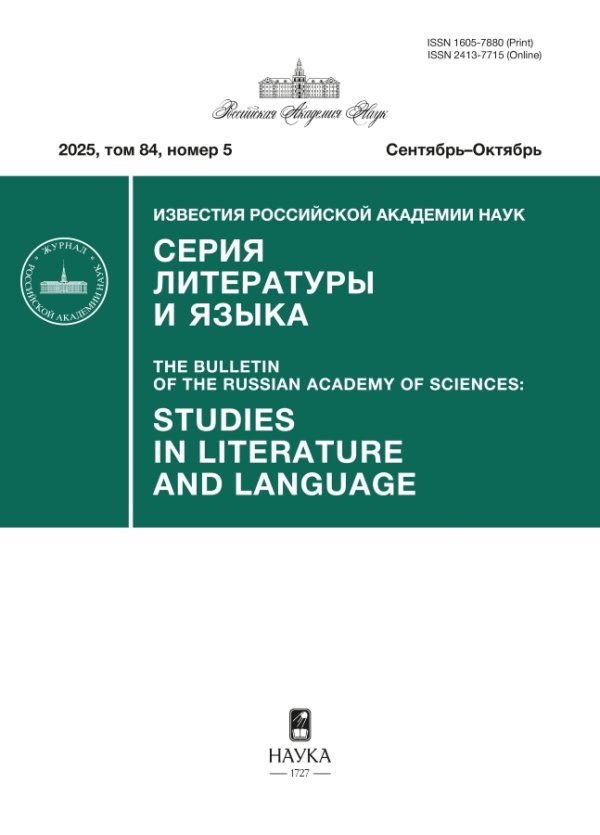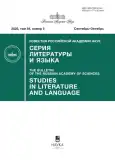The Bulletin of the Russian Academy of Sciences: Studies in Literature and Language
Izvestiya RAN. Seriya literatury i yazyka (The Bulletin of the Russian Academy of Sciences: Studies in Literature and Language), founded in 1852 by Academician Izmail I. Sreznevsky, is the oldest academic journal in Russia for scholars of philology.
Publication history: from 1852 to present.
Founders
- Russian Academy of Sciences
Publisher
- Russian Academy of Sciences
The journal is published under the supervision of the RAS Department of Historical and Philological Sciences (OIFN RAS).
About the journal
As the official journal of the Division of Historical and Philological Studies of the Russian Academy of Sciences (in Russian, ОИФН РАН), Izvestiya RAN. Seriya literatury i yazyka (The Bulletin of the Russian Academy of Sciences: Studies in Literature and Language) is committed to carrying on the Russian philological traditions while seeking to publish innovative research.
The journal offers papers on aspects of literary and linguistic studies, including discussions of fundamental philological works, review articles and chronicles, and transactions of the Division of Historical and Philological Studies of the RAS. One of the journal’s main sections is devoted to resurrection of undeservedly disregarded events from the history of philological scholarship in our country.
Among The Bulletin of the Russian Academy of Sciences: Studies in Literature and Language’s contributors there are Academicians and correspondent members of the Russian Academy of Sciences, researches from academic institutes, many internationally recognized scholars from Moscow, Saint Petersburg, different Russian regions, as well as eminent scholars from other countries.
Editor-in-Chief
- Vadim Polonsky, Corresponding Member of the RAS, Dr. Sci. (Philology), Prof., A.M. Gorky Institute of World Literature of the Russian Academy of Sciences (Moscow, Russia)
Editorial Staff
- Deputy Editor-In-Chief – Leonid Krysin, Dr. Sci. (Philology), Prof., V.V. Vinogradov Russian Language Institute of the Russian Academy of Sciences (Moscow, Russia)
- Executive Editor – Alexander Piperski, Cand. Sci. (Philology), Higher School of Economics (Moscow, Russia)
- Scholarly Editor – Vladimir Korovin, Dr. Sci. (Philology), Assoc. Prof., Lomonosov Moscow State University (Moscow, Russia)
- Editorial Manager – Olga Lukashenko
Subjects
Literature and Language, Linguistics, History of Russian and World Literature, Literary Theory, Folklore Studies, Aspects of History of Art.
Main Headings
- Original Papers
- From the History of Philology
- Reviews
- Chronicles
Frequency
The journal is published bi-monthly (6 issues per year).
Indexing
- RSCI (Russian Science Citation Index) by Clarivate Analytics and eLIBRARY.RU
- ERIH PLUS
- Citation Index by eLIBRARY.RU (Scientific Electronic Library)
- Crossref
The journal is included in the Russian Higher Attestation Commission List of peer-reviewed scientific publications.
Current Issue
Vol 84, No 5 (2025)
Articles
The Main Myth in Thomas Mann's Novel Doctor Faustus (On the 150th Anniversary of the Writer's Birth)
Abstract
The ideational structure of “Doctor Faustus” is examined in the article amid the humanism crisis problem, which came to a head during the fascist dictatorship period. The saving of humanism was conceived by Thomas Mann and his contemporaries as a cultural task solution that was outlined but not solved by either the Renaissance or the era of Goethe: overcoming the gap between cultural creativity and socio-political practice. The author includes T. Mann’s novel in the field of anti-fascist humanistic discourse of the twentieth century’s thirties and forties, proving that the correlation between the tragedy of the hero’s life and the tragedy of Germany does not mean their equivalence, their identicalness. The novel dual temporal structure, which ensures the two plot lines connection – the biography of the artist and the history of Germany – finds its correspondence in the doubling of the mythological hyperplot: the counterpoint of the hero’s theme and the theme of Germany is incorporated by T. Mann into the semantic space of the Faustian myth of German literature, which, in turn, is actualized in the light of the myth of the “third humanism” aesthetic culture. In the utopian perspective of total synthesis (of God and the world, spirit and life, art and politics, individuality and society), fascism is metaphorized in the image of world’s evil, and the hero’s alliance with the demonic forces of hell appears as a negative phase of the apocalyptic “outcast–chosen” dialectic and a redemptive sacrifice in the name of saving Germany and humanity.
 5–14
5–14


Visionary Fiction and Posthumous Narration: Similarities and Differences
Abstract
The article considers the problem of genesis and evolution of the modern posthumous narration, i.e. the narration of a character who, in the conventional reality of the inner world of the work, is represented as a dead person. The question is raised about how the genre of vision, which is close to the narrative from beyond the grave in a number of respects, relates to it. Structural similarities and differences between vision and posthumous narrative are revealed. It is established that three fundamental characteristics of the posthumous narrative are only partially inherent to visions: in this genre there is also a description of the “other” world, albeit fragmented, but the subject of vision goes there without dying or while being in an uncertain position between life and death, and most importantly, the narration is not transmitted to this person in its totality (and if in the rarest cases it is transmitted, then the subject of vision is not dead, but alive). The extreme cases of the convergence of vision with posthumous narrative as such are noted when the narration in the vision is characterized by rudiments of the syncretism of the subject and fragments of the story are told by the visionary himself, who at that moment has not yet been resurrected. The limit to such a convergence is set by the fact that, according to the laws of the genre, the visionary is ultimately resurrected, which does not happen in posthumous narrative, and the “transfer” of the narrative to a dead person is not an artistically conscious device, but an extremely “tenacious” rudiment of the syncretic stage of the evolution of poetics.
 15-24
15-24


Child-Directed Speech and Early Acquisition of Personality
Abstract
 25–51
25–51


Anti-Theatricality in the 17th Century French Salon: On the Question of Maxim 81 of the Marquise de Sablé
Abstract
 52–58
52–58


Genitive Case Singular Forms of the 3rd Person Feminine Pronoun in the Russian Literary Language of the 18th–19th Centuries and Modern Russian Dialects
Abstract
 59–69
59–69


“Russian” and “Soviet” in Claude Simon’s Novel “The Invitation” (1986): The Reception of the USSR in the French “New Novel”
Abstract
 70–77
70–77


On the Problem of Creating an Empirical Basis for a Normative Explanatory Dictionary
Abstract
 78–98
78–98


Verbs of the Semantic Field of ‘Mixing’ in Shughni
Abstract
 99–111
99–111


Chaucer and Langland’s “Poor Widow”: Symbolism and Context
Abstract
 112-116
112-116


Which Source did Küchelbecker Use to Translate Calderón? An Episode of the Reception History of Spanish Drama in Russia
Abstract
 117–132
117–132


Zinaida Volkonskaya and J.-P.-F. Théard’s “A Picture of Three Eras”
Abstract
 133–139
133–139


Chronicles
International Scholarly Conference “Isaac Babel in the Context of Russian and World Culture”
 140–147
140–147












